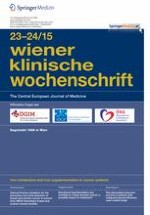01.12.2015 | original article
Lab-score is a valuable predictor of serious bacterial infection in infants admitted to hospital
Erschienen in: Wiener klinische Wochenschrift | Ausgabe 23-24/2015
Einloggen, um Zugang zu erhaltenSummary
Parents frequently bring their children to the Emergency Department (ED) because of the fever without apparent source (FWAS). To avoid possible complications, it is important to recognize serious bacterial infection (SBI) as early as possible. Various tests, including different clinical scores and scales, are used in the laboratory evaluation of patients. However, it is still impossible to predict the presence of SBI with complete certainty. Galetto-Lacour et al. developed and validated a risk index score, named Lab-score. Lab-score is based on the three predictive variables independently associated with SBI: procalcitonin (PCT), C-reactive protein (CRP), and urinary dipstick. The objective of this study was to assess the performance of the Lab-score in predicting SBI in well-appearing infants ≤ 180 days of age with FWAS, who presented to ED and were hospitalized with suspicion of having SBI. Based on this study findings, white blood cells count (WBC), CRP, PCT, and lab-score ≥ 3 were confirmed as useful biomarkers for differentiation between SBI and non-SBI. Also, receiver operating characteristic curve (ROC) analysis confirmed that all of them were useful for differentiation between SBI and non-SBI patients with the highest area under curve (AUC) calculated for the Lab-score. The results of this research confirmed its value, with calculated sensitivity of 67.7 % and specificity of 98.6 % in prediction of SBI in infants aged ≤ 180 days. Its value was even better in infants aged ≤ 90 days with sensitivity of 75 % and specificity of 97.7 %. In conclusion, we demonstrated the high value of lab-score in detecting SBI in infants under 6 months of age with FWAS.
Anzeige
